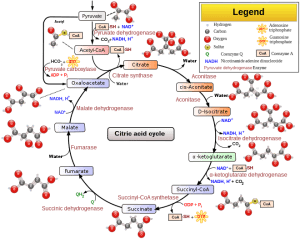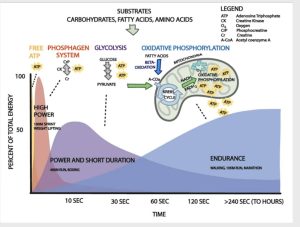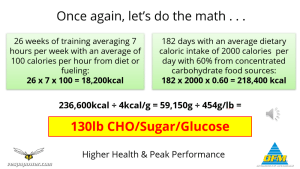 What is your Optimal Fat Metabolism?
What is your Optimal Fat Metabolism?
Optimized Fat Metabolism (OFM) is a program designed to enhance the body’s natural ability to burn fat as a primary fuel source during aerobic activities, particularly in endurance sports. This approach allows athletes to rely on fat stores for energy, reducing the dependence on carbohydrates. The benefits of OFM include improved physical performance, faster recovery, better body composition, and more stable energy levels.
OFM, or Optimized Fat Metabolism, is a program that retrains the body to prioritize fat as its primary fuel source for aerobic activities, even at higher intensities. This fat-adaptation allows athletes to burn fat more efficiently, pushing beyond what traditional science considers possible. Once adapted, athletes can also use carbohydrates more strategically, with less reliance on them during performance.
Overview:
VESPA is a natural supplement designed to optimize fat metabolism by promoting the body’s ability to use fat as a primary fuel source during endurance activities. It plays a key role in the “Optimized Fat Metabolism” (OFM) approach, which focuses on enhancing athletic performance by shifting the body away from a reliance on carbohydrates and instead utilizing fat stores for energy. Here’s how VESPA and OFM work together:
1. Fat as Fuel
- OFM aims to reset the body’s metabolism to efficiently burn fat, even during higher-intensity efforts, contrary to the traditional high-carb fueling approach.
- Humans have limited glycogen stores but large fat reserves, which VESPA helps tap into, making fat the primary fuel source, especially for endurance athletes.
2. Strategic Carbohydrate Use
- OFM doesn’t eliminate carbohydrates but rather incorporates them strategically. Once fat-adapted, smaller amounts of carbs are used for quick energy during high-intensity efforts. Carbs become more potent and effective in these situations.
3. VESPA Integration
- VESPA is derived from a peptide found in the Asian Mandarin wasp, which relies on fat for energy during long flights.
- This supplement helps “lock” the body into a fat-burning state by enhancing fat metabolism, which allows athletes to improve endurance and recovery.
- Athletes using VESPA often report enhanced endurance, quicker recovery, and less reliance on carbohydrates during prolonged efforts.
4. Health & Performance Benefits
- Enhanced Endurance: Athletes using OFM and VESPA can maintain energy levels by tapping into fat stores, reducing the risk of glycogen depletion or “bonking.”
- Fewer Gastrointestinal Issues: Fat-adapted athletes often experience fewer digestive problems since they don’t rely heavily on carb-dense fuel during events.
- Improved Recovery: Fat as a cleaner energy source produces less oxidative stress, helping speed recovery and reduce inflammation.
- Mental Clarity: Fat metabolism leads to stable, sustained energy levels, improving mental focus and emotional balance during long activities.
5. OFM Pyramid
- The OFM Pyramid helps athletes customize their approach based on personal goals and training needs, with the foundation being fat adaptation.
- As athletes progress through the pyramid, they reach “The Zen of OFM,” where fat metabolism becomes effortless and intuitive.
6. OFM vs. Ketogenic Diet
- Unlike a strict ketogenic diet, OFM encourages fat adaptation but includes strategic carbohydrate intake for performance improvements.
- Athletes vary their carb intake based on training and competition needs rather than maintaining a rigid low-carb or high-fat approach.
In summary, VESPA supports the body’s ability to metabolize fat efficiently, which helps athletes achieve better endurance, recovery, and performance by leveraging fat as the primary energy source while still incorporating carbs when necessary. This makes it an adaptive framework tailored to each athlete’s specific needs.
OFM was originally developed for VESPA athletes to unlock the significant performance and health benefits of fat metabolism. By focusing on burning fat for energy, the program enhances aerobic capacity, allowing athletes to maintain higher levels of performance with less oxidative stress, inflammation, and quicker recovery.
VESPA helps with high-intensity workouts by enhancing fat metabolism, allowing the body to rely less on glycogen and more on fat for energy, even during periods of intense effort.
Here’s how VESPA works:
- Fat Utilization at Higher Intensities:
- VESPA promotes the body’s ability to continue burning fat as fuel during higher-intensity exercise, which is traditionally when the body switches to burning glycogen (carbohydrates) for quick energy. By staying in a fat-burning state longer, athletes can preserve glycogen stores for critical moments, such as sprints or bursts of high power.
- Glycogen Sparing Effect:
- During high-intensity efforts, VESPA helps spare glycogen, which means athletes can rely on their limited glycogen reserves when it’s most needed, like for quick, explosive movements or final efforts in a race.
- This prevents athletes from “bonking” (running out of glycogen) too early.
- Efficient Energy Production:
- Because fat stores are vast compared to glycogen stores, VESPA allows for a more sustained energy output over the course of the workout.
- This helps athletes maintain their performance levels over long, intense sessions, preventing the crashes that come from depleting glycogen too quickly.
- Reduction of Oxidative Stress:
- Fat metabolism produces less oxidative stress compared to glycogen metabolism, especially during high-intensity efforts.
- This can help reduce inflammation and muscle damage during intense exercise, improving recovery.
- Enhanced Recovery Between High-Intensity Intervals:
- Since VESPA promotes fat oxidation, athletes can recover faster between high-intensity intervals.
- With less reliance on glycogen, they experience more stable energy levels, preventing rapid fatigue during interval sessions.
- In essence, VESPA allows athletes to stay in a fat-burning state longer, use glycogen more strategically, and maintain energy and performance during high-intensity workouts without relying solely on carbohydrates.
- This not only improves endurance but also helps athletes perform better during short, intense efforts.
Key Features of OFM:
- Resetting Fat as Fuel: OFM promotes the body’s natural ability to burn fat across a broad aerobic spectrum, optimizing fat metabolism even at high aerobic levels.
- Strategic Carbohydrate Use: Instead of eliminating carbs, OFM enhances their effect by using them more effectively during critical moments of intense activity.
- Integrated and Personalized: OFM is not a one-size-fits-all program. It offers a flexible framework, empowering athletes to incorporate its principles based on individual needs and goals.
Benefits of OFM:
- Improved Performance: By using fat for fuel, athletes can sustain energy for longer periods without the risk of bonking.
- Faster Recovery: Less oxidative damage allows for quicker recovery and muscle repair.
- Improved Body Composition: Athletes often see better ratios of lean muscle mass to fat.
- Mental and Emotional Stability: Fat metabolism provides a steady energy supply, improving focus, coordination, and mood.
- Reduced GI Issues: Many athletes report fewer gastrointestinal problems during endurance events.

OFM challenges the traditional carb-heavy approach by focusing on the body’s natural design to use fat as the primary fuel for sustained aerobic activities.
While carbohydrates are crucial for short bursts of energy, fat provides a more sustainable fuel for endurance. Athletes who embrace this shift see improvements in overall performance, health, and well-being, often defying the conventional wisdom of sports nutrition.
In conclusion, OFM is not about restricting carbohydrates but optimizing how the body uses fat for fuel.
It allows athletes to tap into their natural fat stores, creating a more efficient, flexible, and sustainable way to perform at their best.
So, what if we removed a third of all that sugar? That is 50 pounds! . . . and that leaves you with 100 pounds of sugar to fuel your performance….knock out half, that’s 75 pounds but leaves you with 75 pounds of carbs for performance. Does any of this look keto to you?OFM achieves all this and more……by optimizing your fat metabolism so you can go all day and recover.



Here’s how OFM works:
1. Fat as Fuel:
- OFM focuses on resetting the body to metabolize fat efficiently, even at higher aerobic intensities, which is contrary to traditional approaches that emphasize carbohydrate dependence.
- Humans naturally store large amounts of fat and limited glycogen, making fat an abundant source of energy for endurance activities.
2. Strategic Carbohydrate Use:
- OFM does not eliminate carbohydrates but uses them strategically.
- Once fat-adapted, athletes can use smaller amounts of carbs for quick energy bursts during higher-intensity efforts, making carbs more potent and effective.
3. VESPA Integration:
- VESPA, a supplement based on the peptide found in the Asian Mandarin wasp, helps lock the body into a fat-burning state.

- This supplement was key in the development of OFM, allowing athletes to experience significant improvements in endurance and recovery by optimizing fat metabolism.
4. Health & Performance Benefits:
- Enhanced endurance: Athletes can access the body’s large fat stores for long periods of aerobic activity without “bonking” (running out of glycogen).
- Reduced gastrointestinal issues: Athletes who rely on fat as fuel often report fewer stomach issues during training and races.
- Improved recovery: Using fat for energy leads to less oxidative stress and inflammation, which speeds up recovery times.
- Mental clarity: Stable energy from fat metabolism helps maintain mental focus and emotional stability during prolonged efforts.
5. OFM Pyramid:
- This tool helps athletes customize the program based on their individual needs and training goals.
- It breaks down into seven core elements, with the foundation being a “fat-adapted” metabolic state.
- As athletes advance, they experience “The Zen of OFM,” where fat metabolism becomes effortless and intuitive.
6. OFM vs. Ketogenic Diet:
- OFM is not the same as a strict ketogenic diet.
- It encourages fat adaptation but still incorporates carbohydrates for performance gains.
- Athletes adjust carb intake based on training and competition needs, rather than maintaining constant low-carb or high-fat diets.
In essence, OFM offers a holistic, adaptive framework that helps athletes achieve peak performance by leveraging fat as the primary energy source while strategically using carbohydrates to maximize output during intense efforts.
OFM stands of Optimized Fat Metabolism
OFM stands for Optimized Fat Metabolism. OFM essentially resets the body back to burning “fat as fuel” for most of the aerobic spectrum so your body prefers to metabolize fat at high aerobic rates, rates much higher than the current science says is possible but consistent with the emerging science on fat adaptation. Once an athlete is adapted, OFM actually enhances strategic carbohydrate use so now carbohydrates work like they never worked before, using less.
OFM (Optimized Fat Metabolism) was created & developed for VESPA athletes to consistently obtain the “game-changing” performance and health benefits of using VESPA and getting the body back to its natural state of using “fat as your fuel” for aerobic metabolism.
OFM is an integrated, multi-facetted approach to help the athlete make that fundamental shift back to burning “fat as fuel” for aerobic metabolism, even at higher aerobic levels.
Emerging science from the FASTER Study is confirming what VESPA athletes already know; that fat metabolism plays a much larger role than previously thought possible and actually helps make carbohydrate use more powerful and sustainable.
OFM is not a “one size fits all” structured program.
OFM empowers the athlete with the information, scientific basis, and real world application so each athlete can integrate OFM into their daily life by making achievable changes based upon each athlete’s unique situation.
The OFM benefits:
- OFM works with your body’s natural physiology
- Improved Physical Performance
- Faster recovery (really damage prevention)
- Improved body composition; i.e. ratio of lean body mass
- Improved health
- Improved Mental focus/Motor skills/Coordination & Emotional Stability
- Feasibility & Metabolic Flexibility: It’s a LOT easier than most people think!
- Greater Caloric Efficiency
- Carbohydrates have a much stronger, more sustainable effect using less
- No bonking
- Elimination of intestinal issue in most athletes
OFM is based on biological & evolutionary scientific principles and physiology, not upon today’s media driven “sound-bite” science. Many aspects of OFM are initially counter-intuitive and contradict the simplistic “group-think” mentality regarding fat , health and performance, yet deliver real world results for athletes of all ages and abilities across sports. OFM is an outgrowth of VESPA’s commitment to our customers.
The premise:
- Simply put, the human body is designed to perform optimally using “fat as your fuel” for aerobic performance.
- This is why humans carry large stores of fat and very limited stores of glycogen. Look in the mirror and you will see…. .why not optimize utilization of “fat as fuel”?
- Even the leanest athlete carries more than enough “on-board” fat calories to run a 100 miles, cycle a double century or complete an Ironman.
- Think of it this way; Fat is your aerobic energy source and glycogen/glucose is your “fight or flight” fuel.
- So unless your event is the 100 meter dash or Olympic powerlifting, focusing on optimizing fat metabolism via OFM needs to be a fundamental part of your program.
The performance:
Science begins with Observational Evidence.
- VESPA was developed after observing the incredible performance of the Asian Mandarin Wasp, vespa mandarinia.
- This predatory wasp performed its daily feat of incredible strength & endurance primarily utilizing the fat stored in its thorax catalyzed by the peptide fed to it from the larvae. This naturally-occurring peptide is a key ingredient (wasp extract) of VESPA.
- Since VESPA’s inception athletes using VESPA have won competitions and set World Records at the very highest levels of competition in sports ranging from the Olympic Marathon to Figure Skating, however, the connection was never made with consumers pursuing athletic endeavors because “experts” and sports physiology textbooks have been telling us to avoid fat, fat makes us fat and that fat can only serve as a fuel for low intensity to mid-level intensity metabolism in athletes.
- In the past seven years the ultra-endurance sports have seen record-shattering wins and performances by athletes using VESPA and it’s OFM program.
- These out-sized performances are consistent and not one time performances.
- Not only are elite ultra-endurance athletes enjoying the benefits of VESPA and OFM but many older age-group athletes are consistently performing at levels many would not considered possible for humans of any age!
- While VESPA has retained a dedicated following most athletes cannot wrap themselves around the premise of fat-fueled performance because of the carbohydrate centric, fat phobic group-think.
- In spite of these winning performances there exists a psychological disconnect because VESPA’s fat driven approach defies what most people have been led to believe.
What about Carbohydrates?
- OFM does NOT eliminate concentrated sources of carbohydrates from the diet or fueling but, rather, uses them “strategically”.
- VESPA plays a critical role to keep the athlete “locked-in” a high level of fat-metabolism while still being able to utilize carbohydrates.
- Clearly, carbohydrates are a super quick burning energy source providing the kind of energy necessary for quick intense bursts and surges in athletic performance.
- The physiology, peer-reviewed literature, podium and athlete feedback all support the use of carbohydrates.
- The problem is the “un-intended consequences” of over-consumption of concentrated sources of carbohydrates, which, over time, create a host of performance and health deteriorating issues.
- OFM is not no/low carb ketogenic protocol.
- OFM is a program to get the maximum efficiency and performance from the athlete’s aerobic potential via lipolytic pathways (i.e. Lipids/Fat) to build greater physiological capacity to sustainably utilize glycolytic pathways (i.e.carbohydrates) at the upper end of aerobic spectrum and into the anaerobic spectrum.
- While there are times and periods where carbohydrates will be severely restricted our experience is that with most athletes, once they are fat-adapted, the dietary aspects of OFM actually become very simple and easy.
- Based upon athlete feedback and performance the OFM “strategic” use of carbs allows this quick burning energy source to have a stronger, more sustainable impact on performance using significantly less.
Enter OFM:
Seven years ago VESPA began an aggressive support and development effort to gain consistent, measurable performance benefits after polling athletes who were new to using VESPA. Some athletes noticed results, others nothing, while a few said VESPA yielded stomach issues. Even more interesting was some athletes said they noticed great performance one time then not another.
Over these seven years VESPA developed OFM to yield the consistent out-sized performance, recovery and health benefits from using VESPA. Today a small but growing number of mostly ultra-endurance athletes are enjoying the “game-changing” benefits in performance, recovery, and overall health provided by OFM. This has resulted in SUCCESS.
The Paradigm-shift:
- There was a time when most people were led to believe the world was flat and the sun revolved around the earth.
- Think about this for a minute.
- People really believed these “facts” to be true when they were patently wrong! Now step back from what you have been led to believe about sports nutrition, physiology and, most of all, your health; that carbohydrates are the end-all for performance but, most important of all, to the absolute terror you and most people have regarding fat.
- If you know of, heard from, or read/heard an interview/podcast by an athlete who has enjoyed SUCCESS through VESPA/OFM what they are experiencing may sound too good to be true.
- Consider these doubts may be a driven from a mindset and perspective based upon a “flat-earth” perspective.
- The cutting-edge often sounds implausible and is roundly dismissed when it starts to have success because it defies very deeply embedded belief systems. The term for this is Cognitive Dissonance.
- Now take a look around at world health and even the “health” of many athletes who are experiencing energy stability issues including bonking, gastrointestinal issues, re-occurring injuries, slow recovery and declining performance.
- Maybe this is you. Ask yourself; do you want to be carb-addicted or fat-adapted?
Maybe there is a better way: The OFM way.
The OFM Pyramid is a VESPA developed tool so the athlete can understand the complex, highly inter-related aspects of the OFM Program in an intuitive way which allows each athlete to create their own personalized OFM program around their individual needs and situation rather than force them into a “one size fits all” program.
This not only achieves results but makes the OFM program feasible on a long-term sustainable level. When an athlete achieves “The Zen of OFM” OFM becomes effortless and intuitive because not only has the body made the physiological shifts but the behavioral changes that foster consistent optimal performance and health.
The OFM Pyramid is broken down into 7 fundamental elements which combine to form the OFM Program. Each element is broken down further into related sub-sections. Every sub-section is intricately interwoven with the others and important in gaining your VESPA fueled performance potential. The pinnacle is OFM, what we term “The Zen of OFM”, however, it is first necessary to start with a solid foundation, the “Fat-Adapted” Metabolic State.
To learn more go to the OFM Website
the principles and concepts behind Optimized Fat Metabolism (OFM), which centers on enhancing fat metabolism for superior health and athletic performance. Here’s a breakdown of the key points:
1. Strategic Use of Carbohydrates in OFM:
- Purpose: The selective, “strategic” use of carbohydrates is important for giving athletes the extra energy push needed for peak performance. The carbohydrates act as a signal to adapt cellular processes, particularly in mitochondria, making them more efficient and robust.
- Fat Metabolism: By focusing on fat metabolism, OFM athletes can burn fat at unprecedented rates. The approach trains the body to rely on fat as the primary fuel source, with carbs used only when needed for that performance boost.
- Vespa: Vespa is a key supplement in the OFM protocol. While it’s not mandatory, it’s highly beneficial for optimizing fat metabolism, helping athletes reach the OFM state faster by enhancing fat-burning capacity.
2. Hydration in OFM:
- Complex Nature: Hydration is described as one of the most dynamic aspects of OFM.
- Proper hydration is vital for both overall health and peak athletic performance.
- No One-Size-Fits-All: There’s no perfect hydration formula since hydration needs vary by individual, environment, and activity.
- OFM emphasizes learning to intuitively manage hydration by understanding the body’s signals, making it a skill that transcends both athletic and everyday needs.
3. Training & Lifestyle Integration:
- OFM Training: The concept of “OFM Disruptive Periodization Training” highlights a periodized approach to training that aligns with the OFM strategy. This likely refers to tailoring training sessions to optimize fat metabolism while strategically using carbs for peak performance.
- Lifestyle Factors: Sustainable lifestyle changes are essential for achieving the goals of OFM.
- OFM stresses the interconnectedness of lifestyle choices—such as sleep, stress management, and nutrition—with both training and fat adaptation.
4. Stomach & Gut Health:
- Key Components:
- Epithelium: The mucous membrane and epithelial cells lining the stomach and gut.
- Biome: The diverse microbiome, including bacteria, fungi, and archaea, residing within the gut.
- Stomach Acid and Gallbladder Function: These components play roles in digestion, particularly in breaking down proteins and fats.
- Importance of Gut Health: Gut health is fundamental to many aspects of bodily function, including:
- Nutrient Absorption: Ensuring that the body absorbs and converts nutrients into the building blocks of life.
- Energy Delivery: Efficient energy production for overall performance.
- Hormonal Balance: Gut health is closely linked to hormonal regulation, affecting everything from metabolism to stress response.
- Immune System & Inflammation Control: A healthy gut supports a strong immune system, preventing auto-immune diseases and reducing both local and systemic inflammation.
- Long-Term Health: Gut health also influences disease prevention, longevity, and even mental and emotional well-being.
The passage emphasizes the importance of focusing on nutritional elements to build and fuel the body effectively.
By optimizing fat metabolism, you not only improve nutritional uptake and utilization but also reduce the metabolic strain caused by excess calories and nutritional imbalances. This approach plays a pivotal role in metabolic health and athletic performance.

Fat-Adapted Metabolic State:
- Foundation for Metabolic Health & Performance: The state of fat adaptation serves as the core of metabolic efficiency. In this state, the body is trained to rely primarily on fat as a fuel source, especially for aerobic activities.
- Optimized Nutrient Utilization: When fat metabolism is efficient, your body can better absorb and utilize the nutrients from food, reducing the excess metabolic load that comes with consuming too many calories or imbalanced nutrition.
Fat as the Primary Energy Source:
- Aerobic Energy Production: Fat is the ideal fuel for aerobic (endurance) activities. Unlike carbohydrates, which burn quickly and need to be replenished more often, fat provides a more sustained and efficient source of energy during prolonged exercise.
Fat as a Building Block:
- Structural Role: Every essential component in the body—including cells, mitochondria, hormones, enzymes, and genetic material (DNA/RNA)—is built upon and dependent on fats. Optimized fat metabolism supports not only energy production but also the very structure and function of these critical biological elements.

- Benefits of Fat Metabolism:
- Reduced Caloric and Nutritional Load: By efficiently using fat as fuel, there’s less need to rely on high-calorie foods or frequent feeding, leading to a balanced energy intake.
- Sustained Energy: Fat stores provide a more consistent and long-lasting source of energy, particularly for endurance activities, making it an ideal metabolic state for long-term health and athletic performance.
Optimizing your fat metabolism not only enhances your energy efficiency and athletic performance but also supports overall metabolic health by enabling better nutrient absorption, reducing excess calorie intake, and ensuring the proper function of cellular components.
This “fat-adapted” state forms the foundation of a robust, well-functioning metabolic system.
OFM (Optimized Fat Metabolism) is a comprehensive strategy for athletes aiming to maximize fat-burning capabilities while using carbohydrates strategically for performance. Key aspects of OFM include focusing on mitochondrial efficiency, individualized hydration strategies, training and lifestyle integration, and optimal gut health. Together, these elements promote superior performance, health, longevity, and mental well-being.
To improve fat-burning metabolism through nutrition, training, and lifestyle, while avoiding hormone imbalances and metabolic chaos, it’s crucial to focus on metabolic health and balance various systems in the body. Drawing on the principles of optimal fat metabolism (as seen in EndureIQ), insights from Dr. Dan Plews, Dr. Mikki Williden, PNOE metabolism testing, and functional medicine, here’s a comprehensive approach to achieving these goals:
1. Nutrition Strategies for Fat-Burning Metabolism
- Fat Adaptation: Train your body to rely more on fat for fuel, especially during low to moderate-intensity activities, by strategically lowering carbohydrate intake and increasing healthy fat consumption. This can be achieved through:
- Periodized Low-Carb Dieting: Implement periods of lower carb intake with higher fat intake to stimulate fat metabolism, allowing flexibility for carbs around intense training sessions (a principle in EndureIQ). This helps prevent insulin resistance while maintaining metabolic flexibility.
- Metabolic Efficiency Training: According to Dr. Dan Plews, using carb periodization helps preserve insulin sensitivity and promotes fat oxidation. Carbs are consumed strategically around high-intensity efforts or races.
- Whole Foods & Balanced Macronutrients: Focus on nutrient-dense foods such as high-quality fats (avocados, nuts, seeds, olive oil), lean proteins, and fiber-rich vegetables. Avoid processed, high-sugar foods that promote insulin resistance and metabolic dysfunction.
- Time-Restricted Eating (TRE): Intermittent fasting, or time-restricted eating (such as a 16:8 fasting window), can improve insulin sensitivity and support fat metabolism. This allows the body to tap into fat stores during fasting periods while improving metabolic flexibility.
2. Training Strategies for Optimal Fat Metabolism
- Zone 2 Training: Dr. Dan Plews and PNOE testing emphasize Zone 2 aerobic training (60-70% of max heart rate), which is the heart of fat-burning exercise. This training zone enhances mitochondrial function, improves fat oxidation, and increases endurance without overstressing the body.
- PNOE metabolic testing can identify your specific fat oxidation rates and determine the most efficient intensity for fat-burning exercise.
- Personalized feedback from PNOE testing can optimize your training efforts.
- Polarized Training Model: Dr. Plews supports a polarized training approach, where 80% of training is low-intensity (fat-burning zone), and 20% is high-intensity. This method prevents chronic stress and burnout, promoting better metabolic health and hormone regulation.
- Strength Training: Incorporate resistance training 2-3 times per week to build lean muscle mass, which enhances overall metabolism and fat oxidation. Muscle is metabolically active and contributes to better glucose regulation, reducing insulin resistance.
- Recovery Emphasis: Prioritize recovery (sleep, active rest, stretching) to avoid overtraining, which leads to HPA axis dysfunction (stress response system) and disrupts metabolic and hormonal balance.
3. Lifestyle Habits to Optimize Fat Metabolism and Avoid Metabolic Chaos
- Stress Management: Chronic stress activates the HPA axis, leading to excess cortisol production.
- Elevated cortisol disrupts hormones like kisspeptin, which plays a role in reproductive hormone balance, and can cause fat storage (especially visceral fat).
- Implement strategies such as:
- Mindfulness Meditation, Yoga, and Breathwork: These practices help manage stress, reduce cortisol levels, and improve parasympathetic nervous system activation, balancing the HPA axis.
- Adequate Sleep: Aim for 7-9 hours of quality sleep per night, as poor sleep is linked to impaired glucose metabolism, insulin resistance, and increased hunger hormones (ghrelin), which hinder fat metabolism.
- Sleep also regulates leptin, the hormone responsible for satiety and energy balance.
- Cold Exposure & Heat Therapy: Following Dr. Stacy Sims and Huberman Lab’s research on cold exposure, cold plunges (16°C) can stimulate fat burning by activating brown adipose tissue (BAT).
- Sauna use (heat exposure) can promote heat shock proteins, which improve mitochondrial efficiency and aid fat metabolism.
- Hydration: Proper hydration is essential for optimizing fat metabolism, particularly during exercise.
- Electrolyte balance is crucial, especially on lower-carb or ketogenic-style diets, to prevent dehydration and maintain energy levels.
4. Preventing Hormone Imbalances
- Balanced Macronutrient Intake:
- Avoid extreme diets (e.g., zero carbs, overly restrictive calories) that can disrupt reproductive hormones, especially in females.
- Sudden drops in carbohydrates or calories can affect kisspeptin, leading to disruptions in estrogen, progesterone, and thyroid function.
- Carbohydrate Refeeds: Incorporating carbohydrate refeeding days helps avoid hormone imbalances in women and keeps leptin levels optimized.
- Carbohydrates are necessary for proper thyroid function and hormone regulation?
- Avoiding Overtraining: Chronic overtraining triggers HPA axis activation, resulting in increased cortisol, which can suppress sex hormones and lead to amenorrhea or irregular cycles in women.
- Dr. Mikki Williden recommends maintaining a healthy balance between training volume and recoveryto prevent HPA axis dysfunction.
- Supporting Thyroid Health: Functional medicine emphasizes supporting thyroid functionwith adequate nutrient intake (selenium, iodine, zinc, etc.) to avoid metabolic slowdown and hormone dysregulation.
- A compromised thyroid can decrease fat metabolism and lead to weight gain.
5. Insulin Resistance & Functional Medicine Approach
- Improve Insulin Sensitivity: Insulin resistance is a major driver of metabolic chaos and fat storage.
- By adopting the fat-adapted state, PNOE metabolism testing can help measure your metabolic efficiency and identify areas of insulin resistance.
- Functional Medicine Interventions:
- Blood Sugar Regulation:
- Focus on stabilizing blood sugar through the consumption of high-fiber, low-glycemic foods, healthy fats, and lean proteins.
- Reducing sugar intake and processed carbohydrates is essential for avoiding insulin resistance.
- Hormonal Balancing:
- Functional medicine emphasizes testing for and addressing hormonal imbalances through personalized nutrition, supplementation (e.g., magnesium, adaptogens), and lifestyle changes.
- Blood Sugar Regulation:
Improving fat-burning metabolism is multifaceted and requires a balanced approach integrating nutrition, training, and lifestyle:
- Nutrition: Fat-adaptation, carb periodization, whole foods, time-restricted eating.
- Training: Zone 2 training, polarized model, strength training, and proper recovery.
- Lifestyle: Stress management, sleep, hydration, cold exposure, and heat therapy.
- Hormone Regulation: Avoiding extremes in diet and training, balancing macronutrient intake, and preventing HPA axis overactivation.
By optimizing these elements, you can enhance mitochondrial function, prevent metabolic chaos, and achieve fat-burning efficiency while maintaining hormonal balance.
